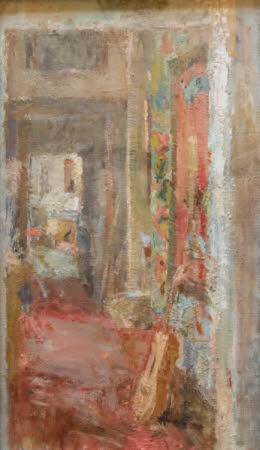Interior in a Corridor with Guitar
Sir Edmund Fairfax-Lucy, 6th Baronet (1945 - 2020)
Category
Art / Oil paintings
Date
2010 - 2020
Materials
Measurements
610 x 355 mm
Place of origin
Charlecote Park
Order this imageCollection
Charlecote Park, Warwickshire
NT 534367
Summary
Oil on canvas, Interior in a Corridor with Guitar by Edmund Fairfax-Lucy (1945-2020), 2010-2020 (unfinished). A corridor at Charlecote Park with a guitar leaning against the wall. The corridor is lined with red carpet and leads to a series of open doors, framing a view into the room beyond.
Full description
This is one of two paintings that Edmund Fairfax-Lucy was working on in the last years of his life (see also NT 534366). It shows a view across the red corridor in the private family wing at Charlecote Park, from the door of the sitting room to the master bedroom. A guitar belonging to Fairfax-Lucy’s sons has been rested casually against the wall, evoking the ongoing role of Charlecote as a family home. Although Fairfax-Lucy's works rarely included figures, they gave ‘the very strong impression of being full of life and activity’ (i). When Fairfax-Lucy came to live at Charlecote in the 1970s, he had just begun to paint interiors and it provided him with plenty of subject matter (ii). He went on to paint many historic house interiors including Petworth, Belton, Boughton, Castle Coole, Anthony, Packwood and Attingham. In 1991 the National Trust curated an exhibition of his interiors at Mompesson House. Fairfax-Lucy was passionate about 17th century Dutch interior paintings, an influence for this work. The focus of the painting is the brightly lit bedroom in the distance. The bedroom is only partially glimpsed, and the viewer is left curious as to what is just around the corner and out of sight. Fairfax-Lucy repeatedly used this device, which is found in many Dutch interior paintings (iii). The painting reflects Fairfax-Lucy’s predilection for depicting subjects through a frame (iv). The view across the corridor also demonstrates his fascination for interval, order and proportion (v). Here Fairfax-Lucy distinguished himself from traditional approaches, commenting ‘William Nicholson would paint the door in straight lines… I blur them so that the eye doesn’t focus sharply on the frame’ (vi). In this manner, the eye of the viewer is drawn beyond the frame and along the corridor. Fairfax-Lucy worked on this painting intermittently for a decade. He took great care and deliberation in determining when a painting might be considered complete, and this painting remained unfinished at the time of his death (vii). (i) Richard Sorrell, The Art Workers Guild, The End of Lunch (The Art Workers Guild, London 2021), p. 23. (ii) Erica Fairfax-Lucy, pers. comms., 6.12.22. (iii) Ibid. (iv) Richard Sorrell, op. cit., p. 23 (v) Paul Hills, ibid., p. 6. (vi) Edmund Fairfax-Lucy quoted in ibid., p. 13. (vii) Alan Dodd, ibid., p. 17.
Provenance
The painting was commissioned by the National Trust from Sir Edmund John William Hugh Fairfax-Lucy (1945-2020) for the Drawing Room at Charlecote Park. It was purchased from his widow, Lady Erica Everlina Penelope Fairfax-Lucy, by the National Trust in 2022.
Makers and roles
Sir Edmund Fairfax-Lucy, 6th Baronet (1945 - 2020) , artist
